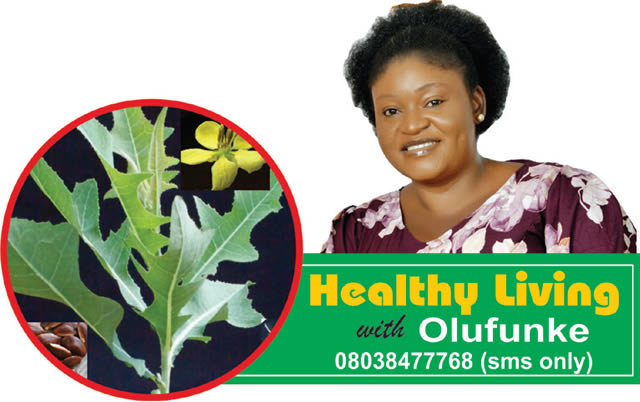
A reader of this column who resides in Canada shared a story with me. I will like to share it with you all. He said an old woman came to Canada to take care of her newly-born grandchild and before leaving for Nigeria, her son decided to take her to a hospital to take advantage of the good medical care over there.
The woman’s blood samples were taken and when the results came out, everything was perfect. Out of curiosity, the doctor interviewed the old woman to know what special thing she does that makes her very healthy at her age. The old woman said she only takes soursop leaves tea! It is this same soursop leaves tea that cured my peptic ulcer. Stories like this give us hope that the future of herbal medicine is great.
In 2021, the World Health Organisation called antimicrobial resistance “one of the top 10 global public health threats facing humanity”. More pathogens are becoming resistant to multiple antimicrobials and that is why these medicines become ineffective, meaning that infections are increasingly hard to treat. Our hunt for alternative treatments to combat disease-causing microbes started last week. It still continues:
9: Scent leaf
It is botanically known as Ocimum gratissimum. It is known as efinrin in Yoruba, nchanwu in Igbo and daidoya in Hausa. Most of us grew up using efinrin as a relief for stomach upset and haemorrhoids but do you know you have probably been plucking your efinrin at the wrong time? Most of its medicinal properties are a function of its essential oil. Hence, the best time to collect this plant is early in the morning when the sun is not out. Once the sun is out, most of the essential oils, which are volatile, would have escaped into the atmosphere. The essential oil of Ocimum gratissimum inhibited Staphylococcus aureus.
10: Cabbage
When bacteria infect wounds, they form biofilms, which delay the healing process. A new study has identified a compound in green, leafy vegetables such as broccoli and cabbage, which inhibits the growth of these biofilms. Red cabbage is a rich source of phenolic compounds, anthocyanins being the most abundant class, which might explain its potent antimicrobial action. This extract is potentially novel for future antimicrobials, inexpensive, and readily available at a large scale for pharmaceutical companies for further investigation and processing. Remarkable antibacterial activity was evident, particularly against highly infectious microorganisms such as Methicillin-resistant Staphylococcus aureus, Escherichia coli O157:H7, Pseudomonas aeruginosa, Klebsiella pneumoniae, Staphylococcus aureus, and Salmonella enterica serovar Typhimurium as well as against human fungal pathogens, Trichophyton rubrum and Aspergillus terreus.
11: Goldenseal
Goldenseal is usually consumed in tea or capsules to treat respiratory and digestive problems. However, it may also combat bacterial diarrhea and urinary tract infections. In addition, results of a recent study support the use of goldenseal to treat skin infections. In a lab, goldenseal extracts were used to prevent MRSA from damaging tissues. Goldenseal also contains berberine, an important component of natural antibiotics.
12: Lemon and lemon peel
In 2011, researchers at the Department of Microbiology, Shivaji University in Kolhapur, India, conducted a study specifically into the antimicrobial compounds present in lemon peel. The researchers found that lemon peel extract was an effective antimicrobial against three common bacteria: Pseudomonas aeruginosa, Salmonella typhimurium, and Micrococcus aureus. In a research work, various concentrations of lime peel extracts were capable to inhibit S. aureus, with the most effective concentration being 40%. The juice is not left out of this antibacterial activity.
13: Tetrapleura tetraptera
It is known as aridan in Yoruba. The plant, very abundant in Ghana, is called prekese (soup perfume) in the Twi language, in Efik it is called uyayak; in Igbo it is called oshosho or osakirisa. Researchers reveal that water extracts and alcoholic mixture of the aridan fruit can inhibit the growth of Staphylococcus aureus. The presence of glycosides and tannins in ethanolic and water extracts of aridan has proved effective for inhibiting the growth of bacteria.
14: Palm kernel oil
In a study, palm kernel oil showed antimicrobial effectiveness on Staphylococcus aureus. The antimicrobial effect is due to its lauric acid content. Palm kernel oil comes from crushing the kernel or the stone in the middle of palm fruit.
15: Herbs
While I discussed how to get rid of garlic breath, I mentioned vegetables/herbs like sage, basil, oregano, marjoram, parsley and mint. The surprising thing is that they all have antibacterial capabilities. Although they are non-indigenous plants, you can get them to buy at supermarkets. You can even get seedlings that you can plant because there are people who farm them in this country.
16: Spices and seeds
I have discussed cloves and some other spices. Here is a list of more spices with antibacterial or antimicrobial capabilities: bay leaf, cinnamon, black pepper, coriander, cumin, black seed, nutmeg, fennel seeds, fenugreek, alligator pepper, mustard seed, African nutmeg, among others.
A study titled, ‘Antibacterial activity of lemongrass (Cymbopogon citratus) oil against some selected pathogenic bacterias’ by Mohd Irfan Naik et al concludes that tested organisms, particularly gram-negative organisms, show high resistance towards different antibiotics whereas they are found to be inhibited by lemongrass oil even at lower concentration. Thus lemongrass oil is effective against drug-resistant organisms.
Another study titled, ‘In vitro antibacterial activity of the red cabbage (Brassica oleracea)’ by Rand Hafidh et al, concludes that red cabbage is a rich source of phenolic compounds, anthocyanins being the most abundant class, which might explain its potent antimicrobial action.
A study titled, ‘Study of lime peel flavonoid as effective antibacterial against Methicillin-resistant Staphylococcus aureus’ by Evy Ratnasari Ekawati et al concludes that the MeOH: DMSO (1:1, v/v) extract of lime peel has bacteriostatic potential.
Another study titled, ‘Antibacterial effects of cinnamon: From farm to food, cosmetic and pharmaceutical industries’ by Seyed Fazel Nabavi et al, concludes that cinnamon use in food products and cosmetics can be a good strategy to reduce or avoid bacterial degradation and thus reduce the incidence of infection caused by food and cosmetics. In fact, cinnamon is not harmful when used in correct conditions.
A study titled, ‘Antimicrobial activity of the aqueous extract of mint plant’ by Basheer Al-Sum et al, concludes that the extracts can be used against multi-drug resistance bacteria capable of causing both nosocomial and community-acquired infections.
A study titled, ‘Antibacterial activity of ocimum gratissimum L. essential oil’ by C V Nakamura et al concludes that the compound that shows antibacterial activity in the EO of O. gratissimum is eugenol.
It will take us months if we want to discuss all the things with antibacterial and antimicrobial capabilities in nature because they are many. I hope you have found the few I talked about useful. However, this does not mean that when situations call for the use of synthetic antibiotics, you should run away from them. After all, I was on antibiotics for my peptic ulcer before trying nature. All I have done is to open your eyes to the fact that for every drug that benefits a patient, there is a natural substance that can achieve the same effect.





